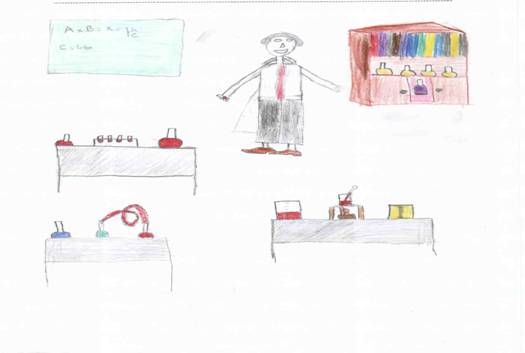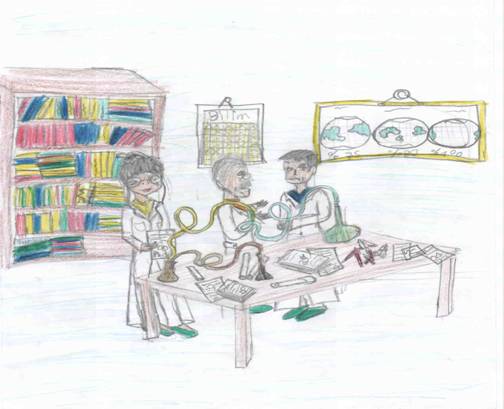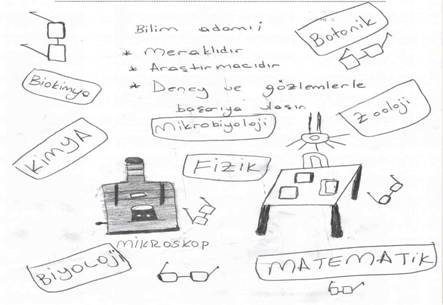Asia-Pacific Forum
on Science Learning and Teaching, Volume 12, Issue 1, Article 5
(Jun., 2011) |
The stereotypical images of scientists wearing glasses and a lab coat, having facial hairs and doing dangerous and secret things decreased compared to those reported in previous studies. In addition, when students get older their stereotypical images of scientists were decreased. They now have more positive image of scientist.
It is interesting to find opposite ideas to most former studies. The results of this study show that student images of scientists are become more positive. Because the drawings include very low percentages of wearing lab coats, indications of secrecy, middle age or elderly scientists, angry or crazy expressions (Table 1).
However, when the question becomes standard images of symbols; the overall results of grades 5 through 11 showed that symbols of doing research (83.4%), symbol of knowledge (16.2), male gender (57.8%), working indoors (23%) and stereotypic images of scientists, including wearing eyeglasses (20%) remain negative. In addition, results show that the negative views are higher among elementary school students than secondary school students. It means that when students get older and have more contact with science and scientist and their views become more positive (Table 1).
Table 1: Stereotypical Image of Scientist by Percentage
Trait
Elementary School (Grade 5 to 8)
Secondary School (Grade 9 to 11)
Female
(N= 96)Male (N=176)
Overall
(N=272)Female
(N=28)Male (N=59)
Overall (N=87)
Lab Coat
3.3%
2.6%
5.9%
3.4%
-
3.4%
Eyeglasses
8.1%
11.7%
19.8%
6.9%
9.1%
16.0%
Facial growth of hair
1.8%
8.1%
9.9%
1.1%
8%
9.1%
Symbols of research
28.6%
55.5%
84.1%
26.4%
35.6%
62.0%
Symbols of knowledge
9.9%
7%
16.9%
5.7%
4.6%
10.3%
Technology
6.3%
16.9%
23.1%
6.9%
12.6%
19.5%
Relevant captions
2.6%
5.1%
7.7%
1.1%
5.7%
6.8%
Male gender
16.2%
45.9%
62.1%
9.2%
21.8%
31.0%
Indication of danger
0.7%
5.5%
6.2%
-
2.2%
2.2%
Presence of light bulb
3.3%
4%
7.3%
3.4%
6.9%
10.3%
Mythic stereotypes
1.1%
6.6%
7.7%
-
3.4%
3.4%
Indication of secrecy
-
0.4%
0.4%
-
1.1%
1.1%
Scientists doing work indoors
6.6%
13.6%
20.2%
14.9%
11.5%
26.4%
Middle age or elderly scientist
0.4%
0.7%
1.1%
-
-
-
Angry or crazy expression
0.4%
4%
4.4%
-
1.1%
1.1%
Figure 1: 5th Grade Female Students Drawing of Scientist
Figure 2: 5th Grade Male Student's Drawing of Scientist
In essays, student positive perceptions of science and scientists were more evident in secondary level. Students explained that science is responsible for progress, improving the health and quality of life, and they work very hard, are patient, open minded, open to criticism, trustworthy, and curious (Table 2).
Table 2: Student Perceptions of Scientists from Students' Essays
Elementary School (N=272) Secondary School (N=87) Type of essays
% Example % Example Plain essays
9.1 Actually, I have never seen scientist before but I want to see one. In my dream, scientists have white hair and wear glasses with angry expressions work with different tools, dedicated his (her) life to science; work in a place where nobody can disturb him. When I heard the word scientist, I was frustrated. After awhile I was used to it. (6th grade, male)
40.2 Our country has not got many scientist but foreign countries have enough. When the countries have enough scientists, they become more powerful and developed. But countries have few scientists that cannot read the develop era (9th grade, female)
Poems
8 Man scientist
Woman scientist
Both are the same actually
Beyond the miracles
Create miracles
Work for people
Develop creative things
Don’t do anything harmful (5th grade, female)-
Word puzzle
4 Have intelligence, have brain, the mind has
Do beneficial things
Guess what is it? (7th Grade, male)- Table 3: Explanation of Science and Scientists from Students’ Essays
What scientist do
Elementary School
(Grade 5 to 8) %Secondary School
(Grade 9 to 11) %Helpful to society and humanity
21.7
46
Produced and invented things
26.8
24
Scientist who
have large brains
0.7
-
objective
-
18.3
curious
1.8
5.7
open to criticism
-
5.7
thinker
1.5
6.9
independent
1.1
8
smart
8.4
10.3
work hard
2.6
6.9
patient
1.8
3.4
can make mistakes
-
1.1
know everything
1.5
6.9
Figure: 10th Grade Female Student's Drawing
Students preferred to use different types of essays including plain writing, poems, and riddles. The analysis of essays showed secondary school students preferred to use both writing and the drawings (57.5%) than the elementary school students (32%). In addition, none of the secondary school students preferred to use any poems or word puzzles while elementary school students preferred to use of poems (8%) and word puzzles (4%) (see Table 2).
In Table 3, Secondary school students defined scientists in more positive ways as being objective (18.3%), curious (5.7), open to criticism (5.7), a thinker (6.9), independent (8%), smart (10.3%), work hard (6.9), patient (3.4%), can make mistakes (1.1%) than do elementary school students. Forty-six percent of secondary school students indicated that scientist’s job is being helpful to society and humanity as well science being responsible for curing diseases, improving quality of life compared to 21.7% of elementary school students.
Interestingly, 4% of elementary school students indicated that they have no exposure to scientists practicing normal science. Students only named ten (10) scientists in drawings and essays mostly by elementary students, including Newton, Aristo, Einstein, Edison, Lamark, Darwin, Arshimed, Magellan, Graham Bell, and Ibni Sina. None of these scientists were female. This is thought to be just because the science textbooks mainly include male scientist figures and their work.
Girls and boys have different views about science and scientists in all grades. Only boys drew monster figures of scientists especially the elementary students (8-students) compared to secondary students (2-students). Regardless of the grade, only girls drew women scientists. Also, girls tend to draw both genders in their drawings more so than boys.
Copyright (C) 2011 HKIEd APFSLT. Volume 12, Issue 1, Article 5 (Jun., 2011). All Rights Reserved.



